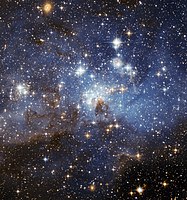
Photo from wikipedia
Tidal dwarf galaxies (TDGs) are gravitationally bound condensations of gas and stars formed during galaxy interactions. Here we present multi-configuration ALMA observations of J1023+1952, a TDG in the interacting system… Click to show full abstract
Tidal dwarf galaxies (TDGs) are gravitationally bound condensations of gas and stars formed during galaxy interactions. Here we present multi-configuration ALMA observations of J1023+1952, a TDG in the interacting system Arp 94, where we resolve CO(2-1) emission down to giant molecular clouds (GMCs) at 0.64" ~ 45pc resolution. We find a remarkably high fraction of extended molecular emission (~80-90%), which is filtered out by the interferometer and likely traces diffuse gas. We detect 111 GMCs that give a similar mass spectrum as those in the Milky Way and other nearby galaxies (a truncated power law with slope of -1.76+/-0.13). We also study Larson's laws over the available dynamic range of GMC properties (~2 dex in mass and ~1 dex in size): GMCs follow the size-mass relation of the Milky Way, but their velocity dispersion is higher such that the size-linewidth and virial relations appear super-linear, deviating from the canonical values. The global molecular-to-atomic gas ratio is very high (~1) while the CO(2-1)/CO(1-0) ratio is quite low (~0.5), and both quantities vary from north to south. Star formation is predominantly taking place in the south of the TDG, where we observe projected offsets between GMCs and young stellar clusters ranging from ~50pc to ~200pc; the largest offsets correspond to the oldest knots, as seen in other galaxies. In the quiescent north, we find more molecular clouds and a higher molecular-to-atomic gas ratio (~1.5); atomic and diffuse molecular gas also have a higher velocity dispersion there. Overall, the organisation of the molecular ISM in this TDG is quite different from other types of galaxies on large scales, but the properties of GMCs seem fairly similar, pointing to near universality of the star-formation process on small scales.
Journal Title: Astronomy and Astrophysics
Year Published: 2020
Link to full text (if available)
Share on Social Media: Sign Up to like & get
recommendations!